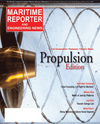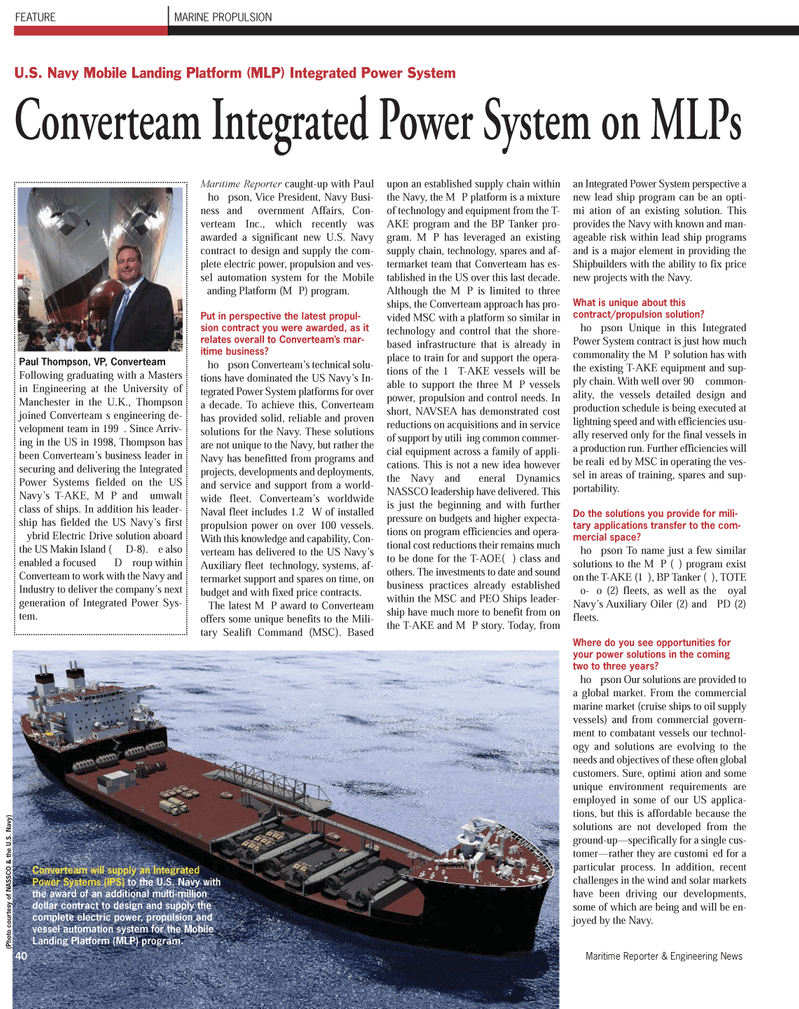
Page 40: of Maritime Reporter Magazine (September 2011)
Marine Propulsion Annual
Read this page in Pdf, Flash or Html5 edition of September 2011 Maritime Reporter Magazine
FEATURE MARINE PROPULSIONMaritime Reportercaught-up with Paul hopson , Vice President, Navy Busi- ness and overnment Affairs, Con- verteam Inc., which recently was awarded a significant new U.S. Navy contract to design and supply the com-plete electric power, propulsion and ves- sel automation system for the Mobileanding Platform (MP) program. Put in perspective the latest propul- sion contract you were awarded, as it relates overall to Converteams mar- itime business?hopson Converteam?s technical solu- tions have dominated the US Navy?s In- tegrated Power System platforms for over a decade. To achieve this, Converteam has provided solid, reliable and proven solutions for the Navy. These solutions are not unique to the Navy, but rather the Navy has benefitted from programs and projects, developments and deployments, and service and support from a world- wide fleet. Converteam?s worldwide Naval fleet includes 1.2W of installed propulsion power on over 100 vessels. With this knowledge and capability, Con- verteam has delivered to the US Navy?s Auxiliary fleet technology, systems, af- termarket support and spares on time, on budget and with fixed price contracts. The latest MP award to Converteam offers some unique benefits to the Mili- tary Sealift Command (MSC). Basedupon an established supply chain withinthe Navy, the MP platform is a mixture of technology and equipment from the T- AKE program and the BP Tanker pro- gram. MP has leveraged an existing supply chain, technology, spares and af- termarket team that Converteam has es- tablished in the US over this last decade. Although the MP is limited to three ships, the Converteam approach has pro- vided MSC with a platform so similar intechnology and control that the shore-based infrastructure that is already inplace to train for and support the opera- tions of the 1 T-AKE vessels will be able to support the three MP vessels power, propulsion and control needs. In short, NAVSEA has demonstrated cost reductions on acquisitions and in serviceof support by utiliing common commer- cial equipment across a family of appli- cations. This is not a new idea however the Navy and eneral Dynamics NASSCO leadership have delivered. This is just the beginning and with further pressure on budgets and higher expecta- tions on program efficiencies and opera- tional cost reductions their remains muchto be done for the T-AOE() class and others. The investments to date and sound business practices already established within the MSC and PEO Ships leader- ship have much more to benefit from on the T-AKE and MP story. Today, from an Integrated Power System perspective a new lead ship program can be an opti- miation of an existing solution. This provides the Navy with known and man- ageable risk within lead ship programsand is a major element in providing the Shipbuilders with the ability to fix price new projects with the Navy. What is unique about thiscontract/propulsion solution? hopson Unique in this Integrated Power System contract is just how much commonality the MP solution has with the existing T-AKE equipment and sup- ply chain. With well over 90 common- ality, the vessels detailed design and production schedule is being executed at lightning speed and with efficiencies usu- ally reserved only for the final vessels in a production run. Further efficiencies will be realied by MSC in operating the ves- sel in areas of training, spares and sup-portability. Do the solutions you provide for mili- tary applications transfer to the com-mercial space? hopson To name just a few similar solutions to the MP () program exist on the T-AKE (1), BP Tanker (), TOTE o-o (2) fleets, as well as the oyal Navy?s Auxiliary Oiler (2) and PD (2) fleets.Where do you see opportunities for your power solutions in the comingtwo to three years? hopson Our solutions are provided to a global market. From the commercial marine market (cruise ships to oil supply vessels) and from commercial govern- ment to combatant vessels our technol- ogy and solutions are evolving to the needs and objectives of these often global customers. Sure, optimiation and some unique environment requirements are employed in some of our US applica- tions, but this is affordable because the solutions are not developed from the ground-up?specifically for a single cus- tomer?rather they are customied for a particular process. In addition, recentchallenges in the wind and solar markets have been driving our developments, some of which are being and will be en-joyed by the Navy. U.S. Navy Mobile Landing Platform (MLP) Integrated Power SystemConverteam Integrated Power System on MLPs Converteam will supply an Integrated Power Systems (IPS) to the U.S. Navy withthe award of an additional multi-million dollar contract to design and supply thecomplete electric power, propulsion and vessel automation system for the MobileLanding Platform (MLP) program. (Photo courtesy of NASSCO & the U.S. Navy) 40Maritime Reporter & Engineering News Paul Thompson, VP, Converteam Following graduating with a Masters in Engineering at the University of Manchester in the U.K., Thompson joined Converteams engineering de- velopment team in 199. Since Arriv- ing in the US in 1998, Thompson has been Converteam?s business leader in securing and delivering the Integrated Power Systems fielded on the US Navy?s T-AKE, MP and umwalt class of ships. In addition his leader- ship has fielded the US Navy?s first ybrid Electric Drive solution aboard the US Makin Island (D-8). e also enabled a focused D roup within Converteam to work with the Navy and Industry to deliver the company?s next generation of Integrated Power Sys- tem.

 39
39

 41
41
